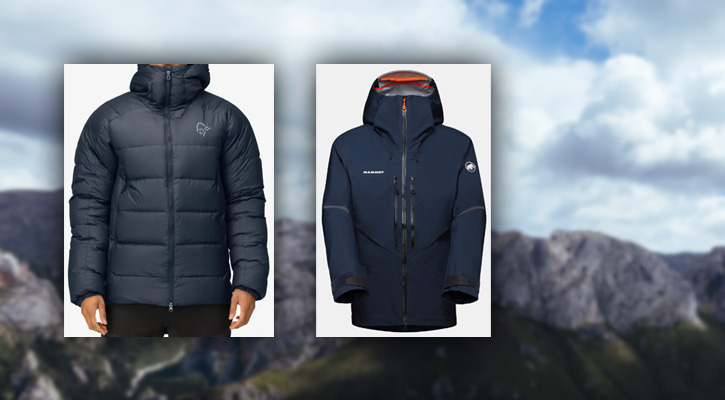
Norrøna and Mammut have a long legacy of crafting high-quality equipment that withstands challenging conditions.
Norrøna was founded in Norway in 1929 when an outdoor enthusiast began searching for outdoor gear for Norway’s harsh climate.
Mammut traces its roots back even further to a ropemaking business established in Switzerland in 1862.
Today, both brands continue innovating technical apparel and equipment while prioritizing sustainability.
In today’s article, we’ll compare Norrøna and Mammut to help you decide which may be a better fit depending on your needs and budget.
We’ll explore the companies’ histories, product lines, materials, prices, and sustainability efforts to identify the main similarities and differences between these leading outdoor brands.
Contents:
1. Norrøna Outdoor Gear
History of the Brand
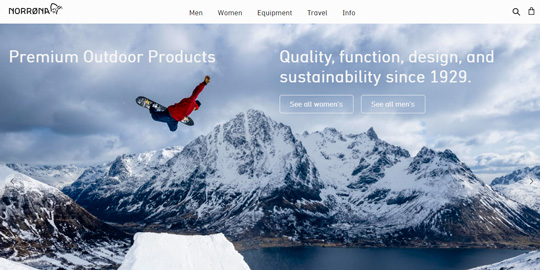
Norrøna official website
In 1929, a Norwegian outdoor enthusiast named Jørgen Jørgensen began the quest for durable outdoor equipment suitable for Norway‘s challenging conditions. This marked the inception of Norrøna, with initial products including leather items, canvas backpacks, and cotton clothing.
By 1948, Bjarne Jørgensen, the second generation Jørgensen, assumed leadership of the company. Over the following years, Norrøna diversified its product range and shifted focus to technical functionality and mountain gear.
In 1971, Ole Jørgen Jørgensen, the third generation Jørgensen, took over as manager, while engineer Tomas Carlstrøm was recruited to aid in the development of backpacks and mountain tents.
Throughout the 1970s and 1980s, Norrøna gained fame for innovative products and sponsoring expeditions, achieving milestones such as introducing the first tunnel tent in 1972, Europe’s first Gore-Tex jacket in 1977, and supplying gear for the winter ascent of Trollveggen in 1979.
Design became Norrøna’s third cornerstone in 2000, with a focus on Loaded Minimalism and clean, functional design. The mid-2000s saw the start of international expansion, with new collections and stores opening in Europe and North America.
In 2015, sustainability was incorporated as Norrøna’s fourth building block, with a commitment to transparency and a pledge to donate 1% of sales to environmental causes.
Presently, four generations on, Norrøna remains a family-owned company headquartered in Norway. Under the stewardship of current manager Jørgen Jørgensen, the company persists in innovating technical outdoor gear rooted in Norwegian traditions.
Don’t miss:
9 Brands like Norrøna: Our Best Alternatives
Norrøna vs Patagonia (Outdoor Gear Comparison)
Materials, Fabrics, and Production Process
Norrøna is dedicated to incorporating high-performance, eco-friendly materials into its product line. The company prioritizes the use of sustainable fabrics such as organic cotton, recycled polyester, recycled nylon, as well as down insulation that adheres to the Responsible Down Standard (RDS) guidelines.
In addition, Norrøna utilizes Bluesign-approved fabrics and is renowned for its commitment to transparency, particularly in achieving 100% organic cotton usage. The company is also recognized for its extensive utilization of recycled polyester.
Norrøna actively participates in initiatives like the Fashion for Good organization to advance sustainability and operates a 1% for Nature program, donating a portion of its annual sales to environmental causes.
The company strives for complete transparency in its sourcing and manufacturing processes, firmly including sustainability as a fundamental principle in its business philosophy.
Norrøna continues to innovate by developing technical products that leverage eco-friendly materials and minimize environmental impact, showcasing its dedication to both performance and the planet in the sustainable outdoor apparel and gear sector.
Like many other high-end outdoor brands, Norrøna incorporates cutting-edge fabric technologies and materials, including various options of Gore-Tex membranes, Polartec performance fabrics, and PrimaLoft synthetic insulation.
The natural down for insulation is from the Pyrenees mountains in France, with bird treatment compliant with high European standards.
The video will be loaded from YouTube.com, a third party. If you play it, you accept their terms of service, and their use of cookies.
Read also:
Haglöfs vs Norrøna: Which is Better for Outdoor Gear?
Norrøna vs Arc’teryx Women’s Ski Jackets: Which Brand To Choose?
Where is Norrøna outdoor gear made?
Norrøna’s outdoor equipment is manufactured in various facilities across Europe and Asia. At the time of writing, the brand utilizes production sites in Lithuania, Spain, Portugal, Denmark, and Sweden within Europe, and in Asia, the manufacturing is carried out in Vietnam, China, and Thailand. (source)
Recommended Products
Norrøna trollveggen down 850 Men’s Jacket
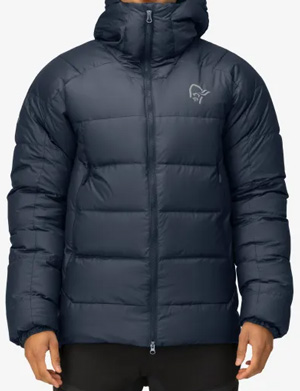
Image: norrona.com
Check it out at Norrona.com
The Norrøna trollveggen down 850 Men’s Jacket represents a high-quality mountaineering down jacket crafted with aeroDownproof face fabric and padded with RDS-certified 850+ fill power down to deliver exceptional insulation without adding excessive weight.
It comes with wind-resistant Pertex Quantum 30D 100% recycled polyester face fabric, 100g PrimaLoft Gold insulation in the pockets and on the shoulders, hand warming pockets, an insulated hood, and an extended back length for added protection.
Read also: 10 Norwegian Jackets and Clothing Brands that You’ll Love
Norrøna lyngen 40L Pack
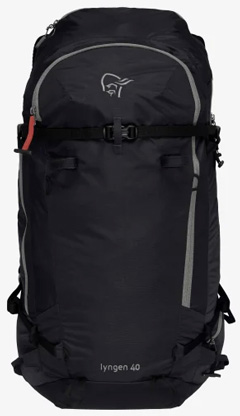
Image: norrona.com
Check it out at Norrona.com
The Norrøna Lyngen 40L Pack is a sturdy and lightweight backpack ideal for ski touring, mountaineering, and trekking. Constructed from robust ECONYL® material using closed-loop regeneration processes, it’s water-resistant and equipped with high-quality YKK zippers.
The backpack features a well-ventilated back with an open-back design and various compartments for avalanche gear, crampons, and a rope. It is specifically designed for transporting ski and snowboard equipment and also includes compression straps, a hip belt with a pocket, ice ax attachments, and a chest strap.
The adjustable shoulder straps are designed with a 3D construction to add breathability.
Read also: 3 Best Norwegian Backpack Brands: Our Top Picks
Prices
Norrøna produces long-lasting and comfortable outdoor equipment made from high-quality materials that endure harsh conditions. Enthusiasts report feeling well-supported and capable of optimal performance even in the most extreme settings, all thanks to Norrøna’s meticulous engineering.
However, the price you have to pay is higher than that of numerous other outdoor companies, with their jackets priced between $300 and $1000, and their backpacks ranging from $100 to $700.
Are Norrøna products worth the price?
In our opinion, Norrøna’s outerwear and equipment offer excellent value for enthusiasts and those who practice difficult outdoor sports and need durable, high-quality gear. The brand offers cutting-edge technology with its jackets for warmth and comfort. Norrøna also offers vibrant colors and designs not commonly found in other brands.
However, for casual outdoor wear or if you’re trying a new sport, this brand is very expensive, and exploring more budget-friendly options may be a better decision.
Learn more: Why is Norrøna so Expensive? Are Their Jackets Worth It?
2. Mammut Outdoor Gear
History of the Brand
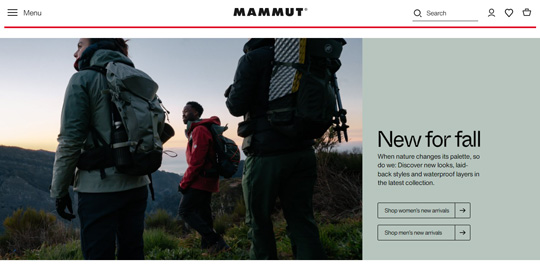
Mammut official website
Mammut is a renowned name in the outdoor apparel sector, originating from Switzerland and tracing its roots back to 1862 when Kaspar Tanner established his ropemaking small business.
Evolving from its humble beginnings, the company has expanded into a global leader in the apparel industry. Despite its extensive history, Mammut continues to employ cutting-edge methods in rope manufacturing, contributing significantly to its overall revenue.
Alongside ropes, Mammut offers a diverse array of products such as backpacks, jackets, hardshells, fleece jackets, softshell pants, rain pants, footwear, and more.
The company places a strong emphasis on sustainability and utilizes premium materials in both clothing and rope manufacturing, reflecting its core values.
Don’t miss:
8 Outdoor Brands like Mammut: Our Best Alternatives
7 Swiss Jacket and Outdoor Clothing Brands: Our Favorites
Materials, Fabrics, and Production Process
Mammut places a strong emphasis on sustainability and upholds the Bluesign standard across its product range. The company is committed to employing eco-friendly techniques and initiatives and is mindful of its production methods.
As part of its efforts, Mammut has implemented a program to recycle old outdoor equipment and is actively striving to phase out PFCs (perfluorinated and polyfluorinated chemicals). Also, the company is dedicated to animal welfare and utilizes non-harmful techniques in its processes.
This ethical stance reflects Mammut’s core values and its unwavering dedication to sustainable practices. In rope production, Mammut opts for materials with a reduced carbon footprint, and its clothing adheres to the Fair Wear Foundation‘s standards.
This commitment to sustainability makes it an ideal choice for environmentally-conscious outdoor enthusiasts.
Some of Mammut’s products feature the renowned Gore-Tex waterproof fabric technology.
The company also utilizes a variety of other materials and fabric technologies, including nylon, polyester, Mammut DRYtechnology waterproof and breathable membrane, Pertex Quantum Pro water-resistant and breathable fabric, PrimaLoft Black synthetic insulation, goose down insulation, and many more.
The video will be loaded from YouTube.com, a third party. If you play it, you accept their terms of service, and their use of cookies.
Read also:
The North Face vs Mammut: Which is Better?
Mammut vs Arc’teryx Outdoor Gear: A Comparison
Where is Mammut outdoor gear made?
Mammut manufactures most of its outdoor gear in Asian countries, such as Vietnam, China, and Bangladesh.
Recommended Products
Mammut Nordwand Advanced HS Hooded Men’s Jacket
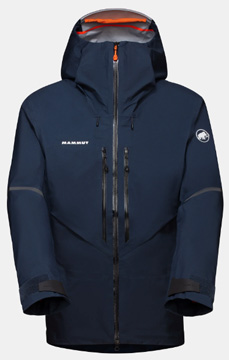
Image: mammut.com
Check it out at Mammut.com
The Nordwand Advanced hardshell jacket is an excellent option for mountain expeditions, offering essential features to improve mobility. Its lightweight, durable, and breathable design, facilitated by the innovative cut and GORE-TEX® PRO fabric technology, ensures reliable protection from the elements while maintaining optimal breathability.
This jacket strikes a perfect balance between features, protection, and pack volume, making it an ideal choice for alpine enthusiasts looking for high-quality gear for their adventures.
Mammut Trion Nordwand 28 Backpack
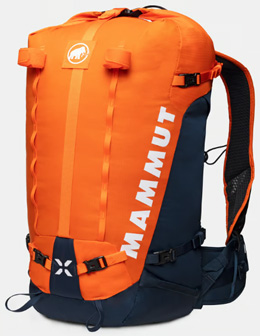
Image: mammut.com
Check it out at Mammut.com
Mammut’s Eiger Extreme Collection includes the Trion Nordwand 28, an adaptable and sturdy alpine backpack. Crafted from premium Cordura material, this pack strikes a balance between being lightweight and long-lasting.
It not only prioritizes durability but also offers great comfort. Esteemed athletes such as Dani Arnold, Nico Hojac, and Stephan Siegrist have played an important role in designing this backpack, with their wealth of knowledge and expertise.
Tailored for high-performing individuals who have high standards when it comes to their gear, the Trion Nordwand 28 is ideal for scaling mountains or for challenging hikes.
Prices
Mammut offers a wide selection of products for individuals with different financial means, ensuring accessibility to a wide consumer base. The product line includes both budget-friendly options and higher-priced items featuring advanced technology and offering superior performance.
For example, Mammut’s jackets typically range from $200 to $300, with select technical designs priced at $900 and above. Similarly, their backpacks are available in a price range of $70 to $800.
Are Mammut products worth the price?
The increased cost is a result of the premium materials and cutting-edge technology employed in Mammut’s production. With a century and a half of expertise in the field, Mammut has established a name for making outstanding products.
We think that Mammut outdoor equipment justifies its high price. The excellence and durability of these products make them a good choice for those in search of top performance for extreme outdoor sports and activities.
But, even in this case, if you’re only planning to practice casual outdoor activities, maybe it’s better to look for more affordable brands.
Must read:
Why is Mammut so Expensive? Is It Worth It?
9 High-End, Expensive Hiking Brands for Clothing and Footwear
3. Which is Better? Norrøna or Mammut?
While both are premium brands offering great quality and durability, here’s what to keep in mind that will help you decide:
Quality: Both brands are known for high-quality, durable outdoor gear. Materials and construction are very robust.
Design: Norrøna tends to have a more Scandinavian minimalist aesthetic. Styles are often sleek and form-fitting. Mammut styles are functional but can have a more outdoorsy look with pockets, straps, etc. Their designs focus on performance.
Temperature Ratings: Both are rated for cold temperatures and are great for alpine and arctic conditions. Norrøna due to its Scandinavian heritage, and Mammut thanks to it being born in Switzerland where there are plenty of mountains.
Features and Materials: Both offer a lot of features like pockets, straps, and organizational features. Both use the latest fabric and insulation technologies such as Gore-Tex, Pertex, Mammut DRYtechnology, Polartec, and PrimaLoft.
Sustainability: both have their programs for environmental protection, waste reduction, and use of recycled materials.
Price: Norrøna is slightly more expensive in general compared to Mammut for similar types of gear. For example, some of Norrøna’s jackets can exceed $1000.
In the end, both brands are excellent for mountain activities and in this case, there aren’t many differences. Norrøna may be better for very cold conditions while Mammut has slightly lower prices. So, it will depend on your budget, fit, and design preferences.
Read next: 11 European Brands for Outdoor Enthusiasts: Our Top Picks
